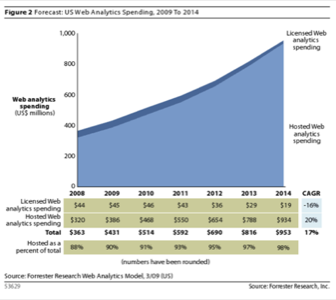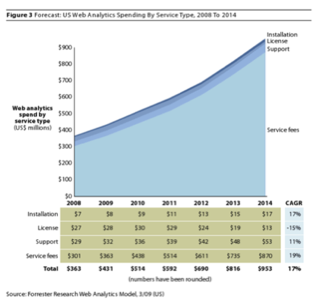In a report covering web analytics from 2008 to the present day and forecasting the industry’s future into 2014, tech research firm Forrester said this area is in an adolescent phase, working through critical changes and preparing for significant growth.

“Forrester forecasts that US businesses will spend $953 million dollars on Web analytics software in 2014, with an average compound annual growth rate of 17%,” the report reads. “Growth will emerge from unexpected places as the value proposition of Web analytics technology oscillates for sophisticated analytics users and becomes more welcoming for new entrants. Ultimately, Web analytics will become part of a broader array of integrated services supporting marketers.”
Currently, around three quarters of all businesses are using or trying web analytics software or services; many of these companies are using free technologies. However, three key areas of misunderstanding are preventing companies from using their web metrics to tweak ROI. Forrester found that both the analytics tools as well as the data being generated were being underused, that staff were not taking action on analytics data, and that the increase in complexity of industry challenges outstrips the growth of the industry itself.
This assessment is undoubtedly bleak, but researchers also identified a few growth factors in the world of web analytics. First, interactive marketing budgets are growing overall. Second, online media is by far the dominant channel. And any money spent on online marketing requires that someone, somewhere be held accountable, that metrics be identified and measures, and that processes be optimized. Forrester also offers the prediction that, given the availability and affordability of web analytics data, a secondary market will spring up to offer services showing companies opportunities for using said data, thus bridging the “action chasm” between knowledge and execution.
In looking at spending, Forrester sees a move away from licensed software and toward hosted web analytics solutions. Service fees will continue to generate revenue for the industry even during turbulent economies; web traffic certainly isn’t slowing down, and neither is the need for capturing accurate data about that traffic. They also see this as a vibrant market for agencies and consultancies. Also, new entrants seeking web analytics for sites with moderate traffic will account for most of the growth in this area.


Finally, because of the availability of versatile, free analytics tools, vendors in this industry are (or need to think about) shifting from “a point solution to an underlying service embedded within broader marketing applications,” wrote Forrester rep Jon Symons in an email this morning.
“The transformation will only have a positive effect as customer intelligence data will be shared more widely across organizations. Significant challenges remain however, including the need for human analysis of mountains of data, the ability to develop metrics that can tie to larger business objectives, and the necessity to integrate marketing and IT organizations in order to achieve true data integration.”
The executive summary is on the Forrester site, and the full report is available for purchase there.

















